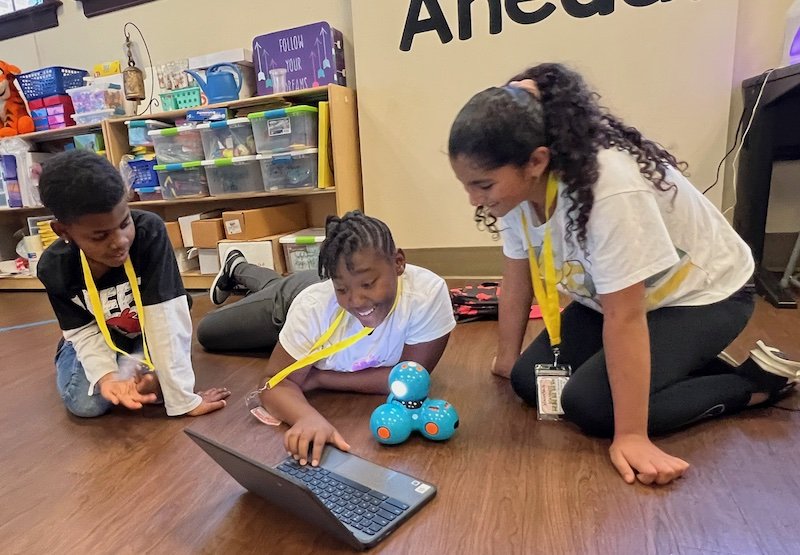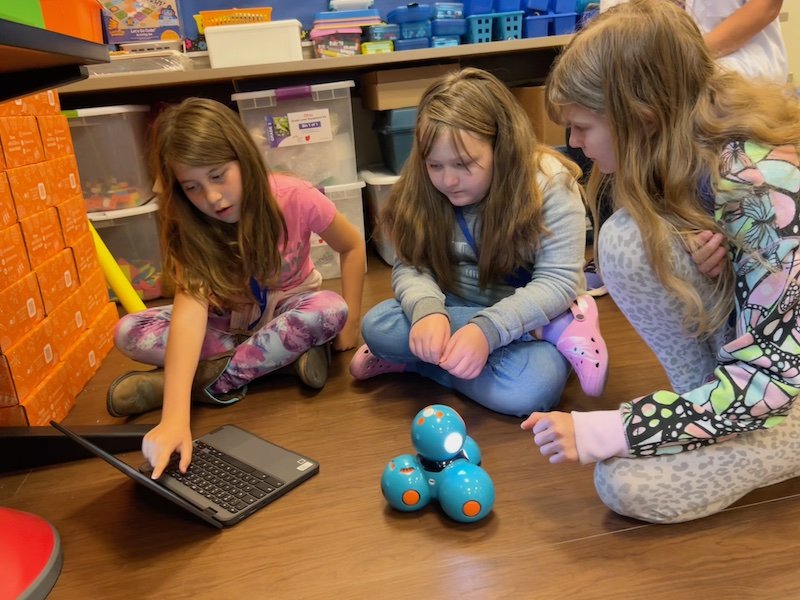Elementary Students STEAMing Ahead
Fifth grade students at Kinder Elementary School were introduced to “Dash and Dot” robots in the fall. Since then, they have been participating in activities to learn basic coding skills using both on and offline projects. They have worked on challenge tasks where they use sequencing, variables, loops, conditionals, and functions.
“I want my students to be passionate about being creative.”
- Jessica Lay, STEAM Lab Teacher, Kinder and Jane Chance elementary schools, Miamisburg City Schools
Jessica Lay’s curiosity, inquisitive nature, and commitment to lifelong learning led her to the teaching profession, and students in the Miamisburg City Schools continue to benefit because of it.
“I was the kid people didn’t always want to teach,” says Mrs. Lay, reflecting on why she became a teacher herself. “I was creative. I wanted to think outside the box. I questioned everything. And it wasn’t out of disrespect; it was out of curiosity.”
While Mrs. Lay recognizes that her curiosity was not always appreciated back when she was in school (likely a sign of the times), she intentionally nurtures it in her students every day.
“I have to make mental notes for 600-and-some kids just to make sure I am meeting all of their needs. That is challenging, but it’s also fun, because I don’t like to be sitting still ever.”
Building a STEAM Lab
True to her nature, Mrs. Lay is “always looking for new things to do.” A 23-year teaching veteran, she has taught math and science in self-contained elementary classrooms and served as a technology “specials” teacher in grades K-5 at Kinder and Jane Chance elementary schools in Montgomery County. Recently, she has become the leader in STEAM education across the Miamisburg district. She plans with teachers across the Miami Valley and coaches staff at both Kinder and Jane Chance on integrating STEAM throughout the school day.
After completing training as a STEM Fellow at the Dayton Regional STEM Center (DRSC), Mrs. Lay received a microgrant to support STEAM activities in her district through a partnership with DRSC and the Martha Holden Jennings Foundation. To begin with, she transformed a former computer room at Kinder Elementary into a hands-on STEAM lab where students in grades K-5 focus on teamwork challenges to learn collaboration, perseverance, and problem-solving skills. All children cycle through the lab once a week for 40 minutes. She works with K-5 students at Jane Chance each week as well.
“I’ve been collecting lots of building materials - Legos, magnet tiles - whatever people don’t want; recycling anything anybody is giving away,” says Mrs. Lay, explaining how she is stocking the new STEAM spaces. “Then I just keep creating, taking other teachers’ ideas, and designing lessons with these hands-on materials.”
Robots can provide hands-on learning for students of all learning backgrounds and styles. They inspire students to think critically and are an exciting way for students to learn abstract concepts in math and STEAM curriculum. Each student moves at their own pace based on mastery of the objectives.
With funds from the microgrant, Mrs. Lay acquired “Dash and Dot” robots in October, which students at both Kinder and Jane Chance schools have been programming to “move, sing, dance, flash their lights, respond to voices, make sounds, and even tell a story.” Students work in teams using Chromebooks to code the robots to accomplish a variety of problem-based tasks. Lessons are interdisciplinary, involving aspects of language arts, math, science, and social studies in the process.
Mrs. Lay first learned of “Dash and Dot” while visiting a classroom in a neighboring district.
“The students were doing the coolest things with them,” she remembers. “I immediately thought, ‘This is so much fun.’ Right away, I went back to my district and started to work on a way to get them for our buildings.”
After working with the robots for several sessions, she says students love the different sounds the robots make and how Dash changes color when the students code it. “We like how Dash moves and pushes things,” one fourth grader remarks, “and it’s really cool when he plays the xylophone.”
With STEAM-related careers on the rise, the use of robotics products is evolving every day, says Mrs. Lay, explaining the necessity for robotic instruction in the STEAM lab. “Teachers need to discover the next generation of students who will work on, program, and create these next-generation devices. Everything in our world is going to be technology-based,” she adds. “It’s just the way of the world. We have to adapt and adjust and become more inventive.”
From teamwork to trial and error to collaboration, Mrs. Lay describes everything she teaches as real-life skills. “It’s just the kid version of real life instead of the adult version,” she says.
In the process of working with “Dash and Dot,” Mrs. Lay expects students to also learn important lessons about trial and error: “I want students to understand that failure is going to happen, over and over again. The robot is not going to make the right sound, or their test is not going to go the way they want it to. But it’s how they pick themselves up and get back to work that makes all the difference.”
Coding the robots also teaches students the importance of following precise steps to solve problems in other areas of STEAM, contributing to “deeper learning” in many content areas.
Mrs. Lay includes STEAM career content in her weekly sessions.
Several months into the school year, Mrs. Lay says she too has learned some important lessons from her work in the STEAM labs: “Perseverance is hard. Teamwork is challenging. I model for students how to solve conflict and how to collaborate with different people to bring out the best each has to offer. Watching these skills then unfold in the students is my favorite part of the job!
“I have also learned that it’s important for us teachers to let go of some of our control. We can guide students, we can lead them, we can show them, we can model for them. But then we have to back up and let the students be the problem solvers and figure things out themselves.”






